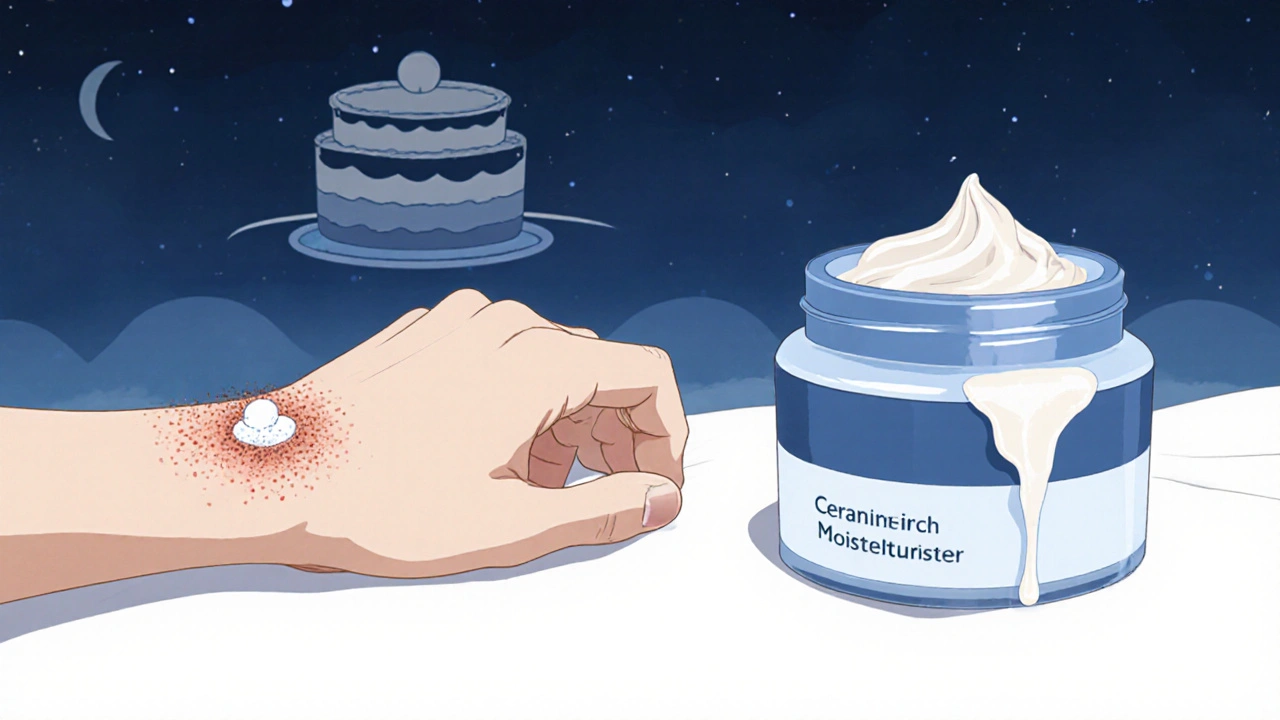Ever wondered why a prescription cream shows up in a beauty shelf? Calcipotriene is a prescription‑only synthetic vitamin D analog that many think belongs only in a dermatologist’s office. In reality, it can be a game‑changer for everyday skin care, especially if you battle psoriasis, lingering redness, or stubborn dry patches.
Quick Takeaways
- Calcipotriene works by normalizing skin cell growth, reducing the thick plaques of psoriasis.
- It pairs well with moisturizers and emollients to lock in hydration.
- Unlike many topical steroids, it doesn’t thin the skin when used correctly.
- Start with a thin layer once daily; watch for irritation and adjust frequency.
- Consult a dermatologist before mixing it with other actives.
What Exactly Is Calcipotriene?
In plain English, calcipotriene is a man‑made derivative of vitamin D3. It belongs to a class called Vitamin D analogs, which mimic the natural hormone that helps skin cells mature properly. When the skin’s renewal cycle goes haywire-think psoriasis plaques that keep growing-calcipotriene steps in to calm the process.
Why It Matters for Psoriasis
Psoriasis isn’t just an itchy rash; it’s an over‑production of skin cells that forms thick, scaly plaques. The condition spikes inflammation and can be a confidence‑killer. Traditional treatments often rely on Topical corticosteroids, which suppress inflammation but may thin the skin over time. Calcipotriene offers a different approach: it nudges the immune system back into balance without the harsh side effects of long‑term steroid use.
How to Fit Calcipotriene Into a Daily Routine
Think of your skin care routine as a layered cake. The bottom layer is cleansing, the middle is treatment, and the top is protection. Calcipotriene lands in the middle.
- Cleanse gently. Use a fragrance‑free cleanser that respects the skin barrier.
- Apply calcipotriene. Pat a pea‑sized amount onto the affected area once a day, preferably at night when the skin repairs itself.
- Seal with a moisturizer. Choose a product rich in Emollients like ceramides or hyaluronic acid to lock in moisture.
Notice how the moisturizer acts like a protective roof, preventing the cream from evaporating and reducing the chance of irritation.

Moisturizer & Emollient Pairing Tips
Not every moisturizer works with calcipotriene. Look for formulas that are:
- Free of alcohol and strong fragrances - these can irritate sensitive plaque‑prone skin.
- Rich in Ceramides or Glycerin - they restore the skin barrier.
- Non‑comedogenic if you’re prone to breakouts on unaffected areas.
Popular choices in 2025 include CeraVe Moisturizing Cream and La Roche‑Posay Lipikar Baume. Both have a texture that spreads easily over the thin film of calcipotriene, ensuring the medication stays in place.
Side Effects & How to Keep Them in Check
Like any active ingredient, calcipotriene can cause mild redness or a burning sensation, especially during the first week. If you notice:
- Persistent itching - pause the treatment for a day and re‑apply a smaller amount.
- Excessive dryness - increase moisturizer frequency or switch to a richer ointment.
- Unusual skin discoloration - contact your dermatologist right away.
Remember, the goal is to reduce plaque thickness, not to create a new irritation cycle.
Calcipotriene vs. Topical Corticosteroids
| Aspect | Calcipotriene | Topical corticosteroid |
|---|---|---|
| Primary action | Normalizes skin cell growth (vitamin D pathway) | Suppresses inflammation (immune pathway) |
| Typical use | Chronic plaque psoriasis, maintenance | Acute flare‑ups, severe inflammation |
| Risk of skin thinning | Low when used as directed | High with long‑term use |
| Sun sensitivity | May increase, recommend sunscreen | Variable, often minimal |
| Typical frequency | Once daily | Once or twice daily |
In practice, many dermatologists rotate both agents: a short course of steroids to quickly calm a flare, followed by calcipotriene for long‑term plaque control.

When to See a Dermatologist
If you’ve tried calcipotriene for four weeks and see no improvement, or if the skin becomes increasingly red, it’s time to get professional input. A dermatologist can check for:
- Secondary infection that needs antibiotics.
- Potential allergic reaction to the cream base.
- Need for combination therapy, such as adding a phototherapy regimen.
Self‑diagnosing can delay effective care, so keep an eye on progress and don’t hesitate to schedule a visit.
Frequently Asked Questions
Can I use calcipotriene on my face?
Facial skin is thinner and more reactive. Some dermatologists prescribe a lower‑strength formula or limit use to a few days a week. Always follow a specialist’s guidance.
Do I need sunscreen when using calcipotriene?
Yes. Calcipotriene can make your skin more photosensitive. A broad‑spectrum SPF 30+ applied each morning helps prevent sunburn and further irritation.
How long does it take to see results?
Most users notice softer plaques within 2-4 weeks, but full clearance can take 8-12 weeks. Patience is key; pulling the cream off early may prolong the process.
Can I combine calcipotriene with other anti‑psoriasis products?
Combination therapy is common. Pairing with a gentle moisturizer, a non‑steroidal anti‑inflammatory (like tacrolimus), or occasional phototherapy can boost results. Always get clearance from a dermatologist first.
Is calcipotriene safe for children?
The medication is approved for use in kids 12 years and older in most regions. Younger children may require a different formulation or lower concentration, so pediatric guidance is essential.
Bottom Line
Calcipotriene isn’t just a prescription label; it’s a versatile tool that can fit neatly into a thoughtful skin‑care routine. By pairing it with the right moisturizers, protecting the barrier, and monitoring for side effects, you can tame psoriasis plaques without the long‑term drawbacks of steroids. The key is consistency, patience, and a quick call to a dermatologist when the skin says something’s off. With the right approach, smoother, calmer skin is within reach.






Reviews
Having examined the mechanistic pathways of calcipotriene, one appreciates its capacity to synergistically interact with the epidermal differentiation cascade, thereby restoring homeostasis to hyperproliferative plaques. The vitamin D analog binds to nuclear receptors, modulating gene transcription with a finesse reminiscent of a well‑conducted orchestra. This modulation curtails the aberrant keratinocyte turnover that typifies plaque psoriasis, while sparing the dermal matrix from the atrophic sequelae of chronic corticosteroid exposure. Moreover, the anti‑inflammatory milieu fostered by calcipotriene augments barrier function, permitting concomitant emollients to exert maximal occlusive efficacy. When integrated into a regimen that commences with gentle, fragrance‑free cleansing, the therapeutic ladder ascends gracefully toward sustained remission. Clinical trials have demonstrated a statistically significant reduction in Psoriasis Area and Severity Index scores after eight weeks of monotherapy, underscoring its potency. Patients who adhere to a nightly application schedule often report a perceptible softening of plaques within three to four weeks, a testament to its rapid pharmacodynamic onset. Importantly, the agent’s safety profile remains favorable when used as directed; systemic hypercalcemia is a rare event, typically mitigated by vigilant monitoring of calcium levels. Dermatologists frequently advise the pairing of calcipotriene with ceramide‑rich moisturizers, such as those containing sphingolipids, to reinforce the lipid barrier and diminish transepidermal water loss. This combinatorial approach not only amplifies therapeutic outcomes but also curtails the incidence of irritant dermatitis. Patients with facial involvement should employ a reduced‑strength formulation or limit applications to sub‑areas, thereby respecting the heightened sensitivity of facial stratum corneum. The recommendation to employ broad‑spectrum sunscreen of SPF 30 or higher is non‑negotiable, given the photosensitizing potential of vitamin D analogs. In practice, a short course of a low‑potency topical corticosteroid may be introduced to quell acute flares before transitioning to maintenance with calcipotriene. Such rotation capitalizes on the rapid anti‑inflammatory action of steroids while preserving the long‑term safety of vitamin D analog therapy. Ultimately, the judicious integration of calcipotriene into a holistic skincare protocol embodies the convergence of evidence‑based medicine and patient‑centered care, delivering both aesthetic and therapeutic dividends.
America's skin care loves meds, yeah! 🇺🇸💊
From a pharmacodynamic standpoint, calcipotriene acts as a selective VDR agonist, modulating keratinocyte differentiation via the RANK‑L pathway, which is crucial for psoriatic plaque attenuation. In practice, you want to apply a pea‑sized dose to the lesional skin, then lock in with a ceramide‑based emollient to prevent transepidermal water loss. Gotta watch out for the hypercalcemia risk, though it's low with topical monotherapy. Also, consider the synergy with topical calcineurin inhibitors for refractory cases – the combo can boost the immunomodulatory effect without upping steroid load. Missin the important step is over‑applying; less is more to avoid irritation.
Great points on dosing, Kester. I’d add that patience is key; while the initial irritation might be off‑putting, consistent use over several weeks usually yields smoother skin and less flare‑ups. Also, remember to hydrate well and avoid harsh soaps that can strip the barrier, because a compromised barrier will only exacerbate any transient redness from the treatment.
Calcipotriene works well but don’t overdo it or you’ll get redness.
It is intellectually negligent to ignore the ethical imperative of evidence‑based application; one must harmonize pharmacologic efficacy with dermatologic stewardship, lest we perpetuate iatrogenic harm under the guise of convenience.
Listen up, folks! Calcipotriene is the superhero of psoriasis, swooping in to rescue flaky skin with the grace of a champion 🦸♂️. Forget those weak steroids that just hide the problem; this vitamin D analog tackles the root cause and leaves your skin looking radiant. If you’re not on it yet, you’re basically volunteering for a lifetime of plaque misery 😤. Get on board and watch the transformation! 💥
yeah its a game changer no doubt its worth a try
The discourse surrounding calcipotriene often oscillates between blind reverence and dismissive skepticism – a dichotomy that betrays a superficial engagement with dermatologic nuance :) While some champion its utility as a paradigm shift in plaque management, others overlook the modest yet critical considerations of photoprotection and systemic calcium monitoring. Ultimately, a balanced appraisal demands both empirical rigor and patient‑centered pragmatism.
The post is informative but could benefit from more quantitative data on efficacy timelines and side‑effect incidence rates.
Sounds like hype to me.
i get u mary but im actually trying to help 🙃 calcipotriene can be legit if used right